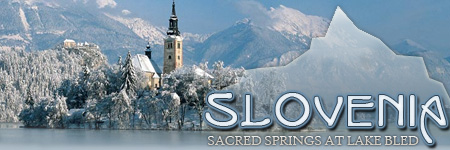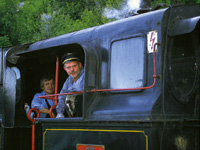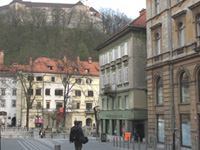|

See the Eastern European Landscape of Slovenia
by Susan McKee
It's
just a mosaic design in the pavement now, but until
1990 the line in front of the historic railway station
at Piazza Transalpina was an actual wall dividing
Western Europe from the communist East. On the Italian
side of the Iron Curtain is the city of Gorizia, and
on the Yugoslavian side, Nova Gorica, Slovenia. As
late as last year, taking the train from Trieste to
Ljubljana meant getting off at the main station in
Gorizia and taking a taxi across the border to the
much smaller Slovenian train station to continue the
journey.
 |
For
2006, its centennial year, the Transalpina Rail Line
is once again connected between Italy and Slovenia,
and it's possible to cross the border by train. In
commemoration, special "Oldtimer" runs are
scheduled between May and September - using an historic
steam engine from the Railway Museum of Ljubljana
to pull the cars along the three-hour scenic route
from the Isonzo River valley to the resort town of
Bled in the Julian Alps.
The
journey chugs along the Soca and Sava river valleys,
crossing the elegantly arcaded bridge of Solkan and
tunneling through almost four miles of mountain at
Podbrdo. The fast-moving river water glows an unearthly
emerald from all the calcium carbonate leached from
the surrounding limestone mountains.
Between the rivers is Triglav National Park, Slovenia's
only national park. Covering 324 square miles, it
includes almost all of the Julian Alps. The highest
point, Mount Triglav is 9,400 feet.
The
region is known for outdoor sports. On the rivers,
there are options for kayaking, canoeing, rafting
and canyoning. Outfitters offer hang-glider lessons.
Mountain bike and hiking trails abound. In the winter,
there's skiing, snowboarding, dogsledding, snowshoeing
and ice climbing.
My
destination was the spa town of Bled, where an ancient
stone castle sets on a rocky bluff towers over a picturesque
village on the shores of an alpine lake. Three thermal
springs are channeled into the pools of local hotels.
In
Lake Bled, formed by the melting of a glacier, is
Slovenia's only island. On that tiny wooded spot of
land is the Baroque Church of the Assumption, built
in the 17th century (although it's been a sacred site
since prehistoric times). These days, it's the setting
for many a modern wedding, even though custom requires
that the groom carry his bride up the 99 steps leading
from the boat dock to the narthex.
The
castle, parts of which are said to date to Roman times,
was gifted by the German emperor Henrik II it to the
Bishops of Brixen in 1011. Today, it's a museum with
a terrace café overlooking the tranquil lake.
The
Transalpina Railway, inaugurated on July 19, 1906,
was part of the Austro-Hungarian Empire's key rail
line between Vienna and its Adriatic port, Trieste.
 |
The
journey by train is a wonderful introduction to Slovenia,
a picture-postcard-perfect European country. Its years
behind the Iron Curtain have preserved an unexpected
gem that Americans have yet to discover. On the northern
perimeter of the former Yugoslavia, this small country
- about the size of New Jersey - provides breathtaking
beauty, a heady dose of history and surprising architecture.
Just
east of Italy and south of Austria, Slovenia combines
the best of both cultures. Along the Adriatic Coast,
the atmosphere - and the architecture - is Venetian.
Inland, sipping tea on the terrace of the castle at
Bled, life has a Teutonic tone. In the capital, Ljubljana,
the Baroque splendor of the Austro-Hungarian Empire
seems to come alive again.
Although
Americans have forgotten their ancient history, this
region was once part of a vibrant Mediterranean culture.
According to legend, the Greek prince Jason was the
founder of Ljubljana. He and the Argonauts, with the
stolen Golden Fleece on board their ship, sailed from
the Black Sea up the Danube, from the Danube into
the Sava, and from the Sava into the Ljubljanica River.
Here, they ran into a fire-breathing dragon. Jason
killed that monster, who is forever immortalized on
the city's coat of arms.
In
more recent times, Elizabeth Kostova began her mesmerizing
New York Times Bestseller, "The Historian",
right in the middle of Ljubljana on the famous 1901
bridge still guarded by four fierce dragons. In her
book, she called the city by its Roman name, Emona.
All around the walkable city center of Slovenia's
capital are, side-by-side, architectural masterpieces
in Renaissance, Baroque and Art Nouveau style seemingly
untouched in a century. There's a lively market most
mornings along the Ljubljanica River where cafés
are plentiful and seafood the main course of choice.
 |
And
you get all this at prices far below what you'd expect
to spend in the more touristy parts of Europe. It's
Prague without the busloads. Hotels that would rate
four stars in Venice or Vienna cost just about $80
a night in Ljubljana. A four-course meal in a fine
restaurant is possible for less than $20. Adding a
bottle of fine Slovenian wine sets you back just $10
or so more.
In
Piran, a medieval walled town on the Adriatic coast,
it's easy to remember that the Venetians used to rule
this region. The language on the street, the menus
in the restaurants and the buildings around the town
square of this sleepy fishing village all are definitely
Italian. On a clear night, you can see the lights
of Venice itself, only 1-1/2 hours by boat across
the Adriatic.
Just a mile south of Piran is the bustling resort
town of Portorož with convention hotels, thermal
spas, a casino and marina.
There
are some 8,100 underground caves in Slovenia. In between
Piran and Ljubljana are the Škocjan Caves, a
UNESCO World Heritage Site since 1986. Arguably the
most beautiful and certainly biggest of the limestone
karst formations is Postojna, the most-visited cave
in Europe (more than 30 million have stopped by since
records were first kept in 1819). The typical visitor
explores just a part of the network of 13 miles of
passages, galleries and chambers, taking some of the
trip underground by train -- but there are adventure
tours available for the true spelunker who asks at
least three days ahead.
|